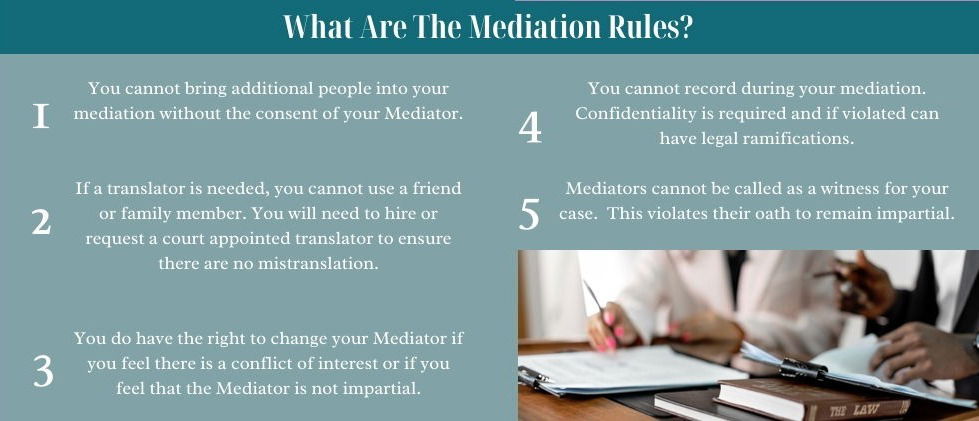Preparing For Your Mediation: Civil Mediation Checklist
Welcome to this pivotal moment on your legal journey. If you're reading this, it means you've reached the mediation stage—an achievement worth celebrating. Take a moment to acknowledge the courage it took to get here. It's perfectly natural to feel a mix of emotions: nervousness, self-doubt, maybe even a hint of disbelief. But remember, you've embarked on this path because you believed in yourself and the pursuit of justice.
Mediation can be an emotionally charged experience, whether you're the plaintiff seeking resolution or the defendant defending your position. Yet, amidst the uncertainty, there's an opportunity for your voice to be heard, and for grievances to find resolution. As you prepare for this important step, it's essential to recognize that outcomes may vary. Mediation is a voluntary process, and the possibility of not resolving your issue exists. However, it's also a space where agreements can be forged, paving the way for healing and closure. Sometimes, despite sincere efforts, conflicts persist beyond the mediation table. External factors and complexities can impact negotiations. In such cases, litigation or arbitration might become necessary avenues for resolution.
Whether you're facing a mediation date or potentially heading toward a courtroom, knowledge is your greatest asset. Whether you have legal representation or not, arming yourself with understanding is key to maximizing the potential of your mediation meeting. You're not alone in this journey; let's navigate it together.


Step 1: Collect and Organize Documentation and Evidence.
Be prepared for your documents, evidence, and timeline of events to be questioned by the opposing party. Mediators are impartial throughout the meeting, however, we may ask questions to gain clarification.
§ Ensure clarity and credibility by labeling each document with dates and subject matter.
§ Employ organizational tools such as color coded folders or dividers to swiftly locate important information.
§ Gather all contracts, emails, images (Not on your phone. Images will need to be printed out), transcripts of verbal conversations (Typically , devices are not allowed into a mediation to play recordings.), or any relevant materials that can establish creditability for your story.
§ Craft a concise timeline to serve as a reference during stressful moments, aiding in memory retention and focus. Writing out large paragraphs is not necessarily for this purpose. This text is solely for reference. During times of stress or anxiety, it is not uncommon to experience a loss of memory.
Step 2: Do Your Research.
§ Categorize evidence into tiers based on strength, emphasizing items aligning most closely with your story to minimize doubt. Allow the supportive evidence to aid in strengthening your main evidence if needed.
§ If you are representing yourself, in legal terms “Per Se”, delve into relevant laws and regulations, spanning federal, county, and state levels, as well as local ordinances if applicable. Online resources can be invaluable for comprehensive understanding. There are plenty of legal sites, government sites, and blogs that have the proper information to guide you.
§ Familiarize yourself with commonly used legal jargon, verifying definitions to maintain credibility and comprehension for yourself. If an attorney is present, these terminologies could be used and not understanding what is being said can lead to confusion. Unfortunately, more often than not, people tend to be misinformed on the meaning of popular legal terms. Do not let that be you! DOJ glossary: https://www.justice.gov/usao/justice-101/glossary
§ Depending on your case., explore past cases and complaints publicly available, drawing inspiration to strengthen your point. (This step is not necessary for smaller conflicts.)
Step 3: Take The Proper Steps to Prove Your Case.
§ "Play Devil's Advocate". Anticipate potential counterarguments and gather evidence to tactically address them. Contemplate excuses, evidence, and documentation that can be used against you.
§ Substantiate statements with tangible evidence, ensuring alignment between claims and documented proof to validate your narrative effectively. For example, hypothetically you are claiming financial hardship. You should be able to supply documentation that can support a financial hardship situation. Documents like a financial hardship letter, bankruptcy, eviction, bank account statements, debt statements, liens, enrollment in any government debt relief programs, W2s statements, IRS forms/letters, and any additional written evidence that can prove your claim.

Step 4: Crafting Your Opening Statement (If required)
§ Keep your statement concise, short, and focused on key points. In high-tension scenarios, most people want to include additional details to prove their case. However, this can lead to unnecessary scrutiny or wasting billable time. In mediation the opening statement is just briefly recanting the situation that occurred.
§ Consider writing out your statement, particularly in complex cases or if anxiety or disability is a factor, to maintain clarity and coherence. This should take no longer than a minute or two to present.
§ Emphasize factual violations, refraining from emotional details unless the event resulted in Post Traumatic Stress Disorder (PTSD) or other mental anguish and can be medically substantiated with tangible evidence.
Step 5: Regulate your emotions.
§ Mediation can be an emotionally taxing experience where wounds can be reopened. It is important to try to regulate your emotions. Understandably, that is a big ask and depending on the situation, may be impossible. Do not hesitate to request breaks to manage stress. A well trained mediator will be able to notice the signs of emotional distress and will either call for a break or caucus (Caucus is when a mediator will separate the parties into different rooms for negations or if tensions run high.).
§ Individuals covered under the American Disabilities Act (ADA) should request an accommodation. Also note, that clients who are suffering from Post Traumatic Stress Disorder (PTSD), Complex Post Traumatic Stress Disorder (C-PTSD), or any other invisible impairment can request accommodation.
§ Maintain composure during proceedings. Utilize provided writing materials, such as pen & paper, for questions and concerns while refraining from violence or threats.
Step 6: Expectations.
Recognize mediation as a negotiation and necessitating flexibility in expectations tend to result in positive outcomes. For cases that involve compensation, know that you will most likely not receive your full desired payout. Consider various potential outcomes, identify areas of flexibility, and assess actual damages to facilitate productive negotiations. Make sure you consider the following before mediation:
§ What is a reasonable outcome?
§ Where can I be flexible regarding the possible outcome?
§ After reviewing the damages, what is the true cost of my grievances?
§ What are the restrictions or constraints of the opposition?
For example: The plaintiff, the lender, wants a $100,000 settlement for an unpaid loan. Prior to the loan being defaulted, the loan accrued $25,000 in interest. The defendant, the lendee, has limited funds and had filed for bankruptcy. It would be unreasonable to expect the defendant to pay a lump-sum of $100,000 today due to his/her financial constraints. It is more likely that the defendant can make installments of 'xxx' over the course of 'x' years due to his/her financial obligations that restrict a higher payout within a certain timeframe. It is possible that the payout will not have interest attached and the defendant may have negotiated to pay under the plaintiff's desired $100,000 with the defendant paying the true debt in the amount of $75,000.

Step 7: Post Mediation Expectations.
If a settlement has been reached:
§ Upon settling, anticipate signing a Settlement Agreement, potentially including Non-Disclosure Agreements (NDA) or Non-Compete clauses depending on the case.
§In court-mediated cases, adhere to state requirements for filing Settlement Agreements and associated documents.
If a settlement has not been reached:
§ If a resolution isn't achieved, consider further legal options or closure of the case from your Mediator or legal counsel. It is not uncommon for a settlement to be reached during litigation if you should choose to move forward in the legal process.
§ Regardless of the mediation outcome, parties are bound by the terms of the Mediation Agreement, including any agreed-upon payments and rules by the Mediator.
In conclusion, preparing for civil mediation demands careful consideration and meticulous planning. From organizing documentation to managing emotions and setting realistic expectations, each step can play a crucial role in navigating the mediation process effectively. By adhering to the checklist provided and adopting a proactive approach, individuals can empower themselves to present their case confidently and work towards a mutually beneficial resolution. Remember, mediation offers a platform for dialogue and negotiation, aiming to resolve disputes amicably and avoid prolonged litigation. Whether a settlement is reached or not, the experience of mediation underscores the importance of communication, understanding, and a willingness to seek common ground. Ultimately, by following these steps and embracing the principles of mediation, individuals can approach the process with clarity, confidence, and the best chance of achieving a satisfactory outcome for all parties involved.
To learn more about what happens after the mediation process please review the "After Mediation" article : https://www.jsmediationservicesllc.com/wellness/after-mediation
